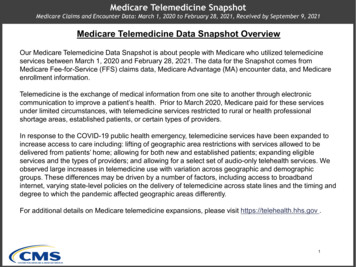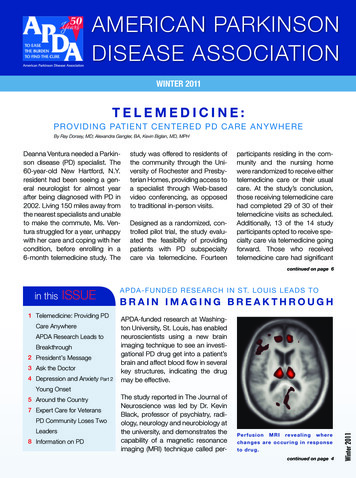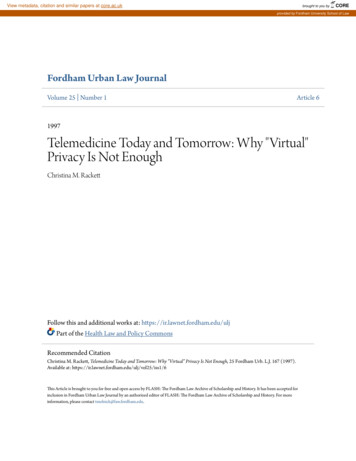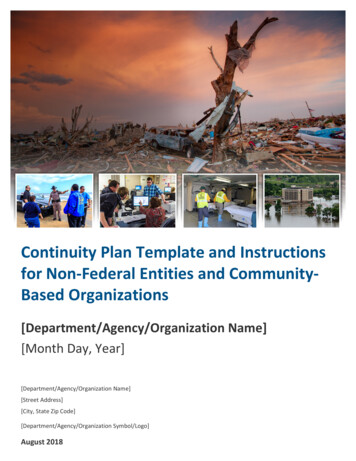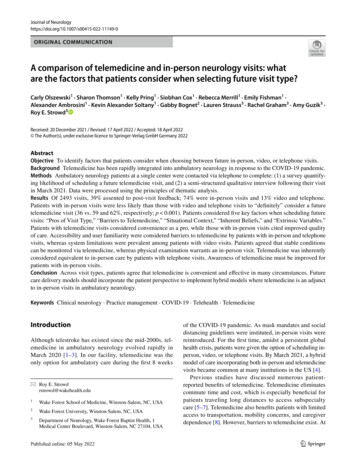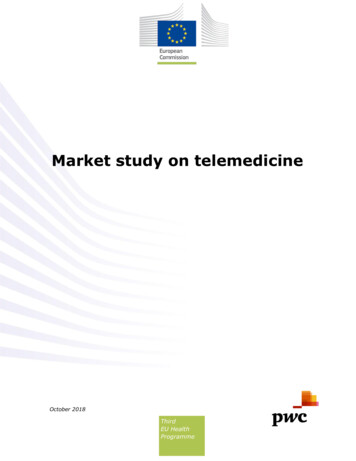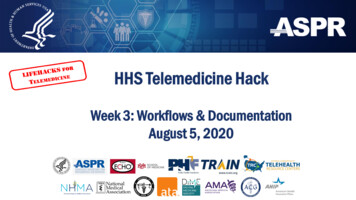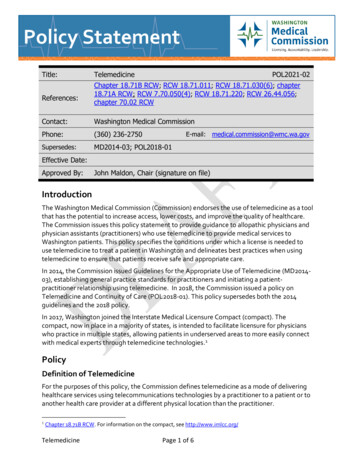
Transcription
Policy apter 18.71B RCW; RCW 18.71.011; RCW 18.71.030(6); chapter18.71A RCW; RCW 7.70.050(4); RCW 18.71.220; RCW 26.44.056;chapter 70.02 RCWContact:Washington Medical CommissionPhone:(360) 236-2750Supersedes:MD2014-03; POL2018-01E-mail: medical.commission@wmc.wa.govEffective Date:Approved By:John Maldon, Chair (signature on file)IntroductionThe Washington Medical Commission (Commission) endorses the use of telemedicine as a toolthat has the potential to increase access, lower costs, and improve the quality of healthcare.The Commission issues this policy statement to provide guidance to allopathic physicians andphysician assistants (practitioners) who use telemedicine to provide medical services toWashington patients. This policy specifies the conditions under which a license is needed touse telemedicine to treat a patient in Washington and delineates best practices when usingtelemedicine to ensure that patients receive safe and appropriate care.In 2014, the Commission issued Guidelines for the Appropriate Use of Telemedicine (MD201403), establishing general practice standards for practitioners and initiating a patientpractitioner relationship using telemedicine. In 2018, the Commission issued a policy onTelemedicine and Continuity of Care (POL2018-01). This policy supersedes both the 2014guidelines and the 2018 policy.In 2017, Washington joined the Interstate Medical Licensure Compact (compact). Thecompact, now in place in a majority of states, is intended to facilitate licensure for physicianswho practice in multiple states, allowing patients in underserved areas to more easily connectwith medical experts through telemedicine technologies.1PolicyDefinition of TelemedicineFor the purposes of this policy, the Commission defines telemedicine as a mode of deliveringhealthcare services using telecommunications technologies by a practitioner to a patient or toanother health care provider at a different physical location than the practitioner.1Chapter 18.71B RCW. For information on the compact, see http://www.imlcc.org/TelemedicinePage 1 of 6
Telemedicine includes real-time interactive services, store-and-forward technologies, andremote monitoring.Store-and-forward technology is the asynchronous or non-simultaneous transmission of apatient's medical information from an originating site to the health care provider at a distantsite that results in examination, medical diagnosis, and treatment of the patient. Remotemonitoring involves the use of digital technology to collect health data from a patient in onelocation and electronically transmit that information securely to a health care provider inanother location for evaluation and treatment decisions.LicensureThe Commission deems the practice of medicine2 to take place at the location of the patientat the time of the encounter.3 Therefore, with a few exceptions detailed below, a practitionerengaging in the practice of medicine with a patient located in Washington must hold an activelicense to practice medicine in Washington. A practitioner licensed in Washington need notreside in Washington to use telemedicine to treat a patient in Washington. A practitionerlicensed in Washington who wishes to treat a patient in another state will likely need a licenseto practice medicine in that state. The practitioner should contact the other state’s medicalboard to find out the requirements for treating patients in that state.The Commission recognizes several exceptions to the general rule that a practitioner isrequired to have a license when treating a patient in Washington. The legislature created aspecific exemption to the licensure requirement for telemedicine practitioner-to practitionerconsultations. The consultation exemption permits a practitioner licensed in another state inwhich her or she resides to use telemedicine or other means to consult with a Washingtonlicensed practitioner who remains responsible for diagnosing and treating the patient inWashington.4.Although this exemption does not apply to direct physician-to-patient consultations, theCommission understands that there are some situations in which a patient in Washingtoncommunicates with practitioners licensed in other states, but that communication does notconstitute the practice of medicine. Some examples are specialty assessment or consultationsuch as a cancer center or a second opinion consultation after a review of medical records. Inthese cases, the practitioner in the distant state does not need a license to practice medicine inWashington. Once the practitioner agrees to advise or treat the patient, the patient musttravel to the state where the practitioner resides, or the practitioner must obtain a license topractice medicine in Washington.Another common situation that is not specifically addressed by a statutory exemption is whena patient with an established relationship with a practitioner licensed in another state crossesthe border into Washington and requires medical care. In some cases, permitting the physicianin the patient’s home state to provide temporary continuous care is in the patient’s bestinterest. This can arise in several common scenarios.2The practice of medicine is defined in RCW 18.71.011 .RCW 18.71B.010.4RCW 18.71.030(6)3TelemedicinePage 2 of 6
In the first scenario, a patient with an established relationship with a practitioner in thepatient’s home state travels to Washington for a limited time (e.g., vacation, business, oreducation) and requires medical care. The patient’s out-of-state practitioner may be the bestperson to provide care via telemedicine while the patient is temporarily in Washington. If thepractitioner knows that the patient will be residing in Washington for an extended period, thepractitioner should develop a plan for emergent treatment agreed to by the patient. This mayinclude a referral to a hospital or to a local specialist who can step in and assist in the case ofdevolving medical or mental status.In the second scenario, a patient who is receiving treatment for a condition by a practitioner ina distant state moves to Washington and requires immediate medical care for that conditionbut has not yet established a relationship with a Washington practitioner. For example, apatient receiving psychiatric care and medication management from a psychiatrist in herformer state may have difficulty finding a psychiatrist in Washington. Temporary care viatelemedicine by the patient’s established psychiatrist may be in the patient’s best interest untilthe patient can find a Washington-licensed practitioner to take over the care.In the third scenario, a Washington resident travels to a distant state to obtain specialty care ata major medical center, then returns home to Washington. The patient may prefer to directlyconsult via telemedicine with the specialists who provided treatment to the patient in thedistant state. Requiring the patient to travel back to the major medical center to receive followup care could impose an unreasonable hardship on the patient. Permitting the practitioner atthe major medical center to provide follow up care via telemedicine is the most optimaltreatment plan for the patient.In each of these cases, the patient needs are best served by having the practitioner who knowsthe patient and has access to the patient’s medical records provide continuous or follow upcare to the patient. So long as the out-of-state practitioner provides temporary continuity ofcare to the patient, the practitioner would not require a Washington license.Standard of CareThe Commission will hold a practitioner who uses telemedicine to the same standard of careand professional ethics as a practitioner using a traditional in-person encounter with a patient.The failure to follow the appropriate standard of care or professional ethics while usingtelemedicine may subject the practitioner to discipline by the Commission.The Commission offers the following guidance to practitioners providing medical servicesusing telemedicine:Scope of practiceA practitioner who uses telemedicine should ensure that the services provided are consistentwith the practitioner’s scope of practice, including the practitioner’s education, training,experience, and ability.TelemedicinePage 3 of 6
Identification of patient and practitionerA practitioner who uses telemedicine should verify the identity of the patient and ensure thatthe patient can verify the identity, licensure status, and credentials of all health care providerswho participate in the telemedicine encounter.Establishing the Practitioner-patient relationshipA practitioner who uses telemedicine must establish a valid practitioner-patient relationshipwith the person who receives telemedicine services. The relationship is established when thepractitioner agrees to undertake diagnosis or treatment of the patient and the patient agreesthat the practitioner will diagnose or treat the patient. A valid practitioner-patient relationshipmay be established through telemedicine if the standard of care does not require an in-personencounter.Medical history and physical examination.Prior to providing treatment, including issuing prescriptions, a practitioner who usestelemedicine should interview the patient to collect the relevant medical history and perform aphysical examination, when medically necessary, sufficient for the diagnosis and treatment ofthe patient. A practitioner may not delegate an appropriate history and physical examinationto an unlicensed person or to a licensed individual for whom that function would be out of thescope of the license.Once a practitioner has obtained a relevant medical history and performed a physicalexamination, it is within the practitioner’s judgment to determine whether it is medicallynecessary to obtain a history or perform a physical examination at subsequent encounters.The technology used in a telemedicine encounter must be sufficient to establish an informeddiagnosis as though the medical interview and physical examination had been performed inperson by the practitioner. A static on-line questionnaire does not constitute an acceptablemedical interview for the provision of treatment, including issuance of prescriptions, by apractitioner.Appropriateness of telemedicineOnly the treating practitioner is empowered to make the decision to use telemedicine with agiven patient. A practitioner should consider the patient’s health status, specific health careneeds, and specific circumstances, and use telemedicine only if the risks do not outweigh thepotential benefits and it is in the patient’s best interest. If a practitioner determines that theuse of telemedicine is not appropriate, the practitioner should advise the patient to seek inperson care.Informed consentA practitioner who uses telemedicine should ensure that the patient provides appropriateinformed consent, whether oral or written, for the medical services provided, A practitionerneed not obtain informed consent in an emergency situation or in other situations recognizedby Washington law. 55Some examples of exceptions to the requirement to provide informed consent are the emergency exception,RCW 7.70.050(4), RCW 18.71.220; medical holds for minors, RCW 26.44.056; and the therapeutic privilegeTelemedicinePage 4 of 6
Coordination of careWhen medically appropriate, a practitioner who uses telemedicine should make referrals to thepatient for in-person services can be delivered in coordination with the telemedicine services.The practitioner should provide a copy of the medical record to other treating practitioners andto the patient upon request.Follow-up careA practitioner who uses telemedicine should have access to, or adequate knowledge of, thenature and availability of local medical resources, including emergency services, to provideappropriate follow-up care to the patient following a telemedicine encounter.Medical recordsA practitioner who uses telemedicine should maintain complete, accurate and timely medicalrecords for the patient when appropriate, including all patient-related electroniccommunications and instructions obtained or produced in connection with the patient visit.The records must be made available to the patient upon request.Privacy and securityA practitioner who uses telemedicine should ensure that all telemedicine encounters complywith the privacy and security measures in the Washington Uniform Health Care InformationAct, chapter 70.02 RCW, and of the federal health insurance portability and accountability act6to ensure that all patient communications and records are secure and remain confidential.Mobile medical technologyThe federal food and drug administration (FDA) regulates the safety and efficacy of medicaldevices, including mobile medical applications that meet the definition of “device” under theFDA Act, particularly apps that pose a higher risk if they do not work as intended.A practitioner who uses a mobile medical technology application that meets the definition of adevice under the federal food and drug act, or relies upon such technology, should ensure theapplication has received approval by the federal food and drug administration or is incompliance with applicable federal law.7Those applications used by a physician or patient that do not have the data to support theirclaims may be investigated by the consumer protection division of the Federal TradeCommission (FTC). If the Commission receives complaints about such apps or devices that aredeemed outside its jurisdiction, the Commission will advise the complainant to contact theFDA or the FTC as appropriate.recognized in Canterbury v. Spence, 464 F.2d 772 (D.C. Cir. 1972, cert. denied, 409 U.S. 1064 (1972); Holt v. Nelson,11 Wn. App. 230, 523 P.2d 211 (1974), rev. denied, 84 Wn. 2d 1008, 523 P.2d 211 (1974).6Also known as the HIPAA Privacy Rule, 45 CFR Part 160, subparts A and E or Part 164.7See dingmobile-medical-applicationsTelemedicinePage 5 of 6
Artificial intelligenceA practitioner who uses artificial intelligence (AI) tools as part of telemedicine to diagnose ortreat a patient in Washington should:(a) Understand that use of an AI tool and acceptance of suggested diagnosis or relatedtreatment plan is at the discretion of the treating practitioner;(b) Understand the limitations of using an AI tool, including the potential for bias againstpopulations that are not adequately represented in testing the tool.A practitioner who uses AI should complete a self-directed CME (category II-V) on bias andunderrepresented populations in health care technology applications such as AI.TelemedicinePage 6 of 6
Phone: (360) 236-2750 E-mail: medical.commission@wmc.wa.gov Supersedes: MD2014-03; POL2018 01 Effective Date: Approved By: John Maldon, Chair (signature on file) Introduction The Washington Medical Commission (Commission) endorses the use of telemedicine as a tool
